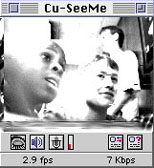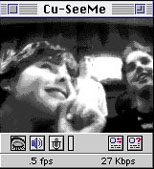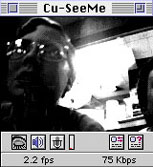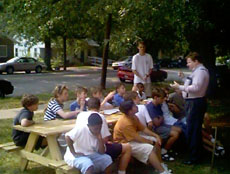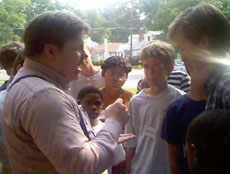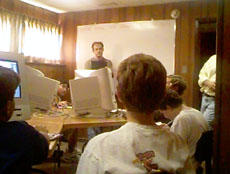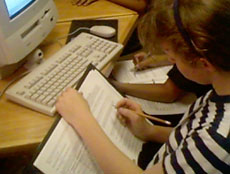|
July 16, 1997 The third day of the Shodor Education Foundation's Internet Explorers Club began at 8:30. The Internet Explorers Club began with a short review of previously learned material. Joe South then led a discussion on search engines, bookmarking, and the creditability of a site--all material covered from day two. Next it was Anne Thissen's turn to take over this delightful group. She first introduced the class to the history of telecommunications applications. Next she let the IEC students experience telecommunicating with each other in a simple program called Talk. The application Talk allowed two people to communicate very quickly over the Internet. The fascinated Internet Explorers thought that this was all that telecommunicating could offer, but they were astonished when Anne introduced them to global chatting. The global chatting program allowed them to communicate with the entire Internet Explorers Club class. All of the IEC students loved global chatting. You could tell this from the intellectual conversations and expressions on their faces.
After experiencing global chatting the IEC students sincerely thought that the Internet's capabilities were exhausted. They were proved incorrect when Anne introduced another telecommunication tool called Cu-SeeMe. The application Cu-SeeMe allowed the students to interact with each other with text, speech, and on a visual-basis. All of the Internet Explorers were flabbergasted when they learned of the full capabilities of Cu-SeeMe. Anne then explained to them that Cu-SeeMe was a form of video conferencing. She then elaborated and said that video conferencing in a form of communication in which two or more people interact with the ability to see each other. The video conferencing exercise seemed to be the most enjoyable exercise that they performed. Next, Alton Patrick enlighten the Explorers on white board applications. "I showed the kids a version of snowflake that lets every user see the changes that others make," explains Alton. "We used it to cooperatively construct a fractal image." All of the Explorers were delighted with white boarding.
To give the Internet Explorers a change of scenery Dr. Robert Panoff, Bob1, took them outside to Shodor's picnic tables. Bob1 stressed to the IEC students about the importance of observation when dealing with almost any task. To illustrate his point he took what appeared to be a carton of eggs with him outside. Each of the twelve "eggs" were either stamped with a "R" or a "H". The IEC students' primary observation led them to the conclusion that the eggs stamped with the "R" were raw and the ones stamped with the "H" were hard boiled. Bob1 then emphasized to the Explorers that in science the obvious answer is often not the correct answer, and that they shouldn't jump to conclusions. After the kids shook each "egg" and spun them and held them up to the light they were sure the eggs labeled "R" were hard boiled and the eggs labeled "H" were in fact still raw. Even after giving the kids several hints that they might be jumping to conclusions, Bob1 cracked open one egg that everyone was sure was hard boiled, and it was an empty egg shell: it did NOT have a liquid center, but that did not mean it was hard boiled. Bob1 cracked other eggs open one at a time, after asking the class to observe its sound when shaken, or its speed when spun. Sure enough, while some eggs were hard boiled and some raw, most were filled with some liquid (water or grape juice!) or nothing. Finally the class was convinced that the best guess they could make was did the "egg" have a liquid center or not. Exactly what the liquid was, could not be observed without cracking open the egg.
Finally, Thomas Dietz exposed the Internet Explorers to the Population Dynamics model deigned by Shodor staff. First, he worked four interations of the mathematical sequence on the board with the population set at one hundred persons. Next, Tom let the Internet Explorers work on a population dynamics worksheet with their partners. After completing the model Tom had the Internet Explorers begin to work on the Flu Epidemic Model. The Internet Explorers left the Shodor Education Foundation with immense knowledge of telecommunicating applications, science observations, and Stella® models. Now, with the knowledge of the Internet and all of its potential , internet Explorers are ready for a new and ever-changing future.
Last Update: June 14, 1999 Please direct questions and comments about this page to WebMaster@shodor.org © Copyright 1998 The Shodor Education Foundation, Inc. |


